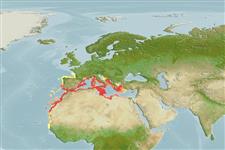Common names from other countries
Environment: milieu / climate zone / depth range / distribution range
Ecología
; rango de profundidad 120 - 800 m (Ref. 106424), usually 330 - 370 m (Ref. 106424). Subtropical; 51°N - 12°N, 20°W - 30°E
Distribución
Países | Áreas FAO | Ecosistemas | Ocurrencias, apariciones | Introducciones
Atlantic Ocean and the Mediterranean: English Channel to Senegal; and in the western Mediterranean from Spain to Sicily and the west coast of Italy, and from Morocco to Tunisia.
Length at first maturity / Tamaño / Peso / Age
Maturity: Lm ? range ? - ? cm
Life cycle and mating behavior
Madurez | Reproducción | Puesta | Huevos | Fecundidad | Larva
Members of the order Decapoda are mostly gonochoric. Mating behavior: Precopulatory courtship ritual is common (through olfactory and tactile cues); usually indirect sperm transfer.
Bisby, F.A., M.A. Ruggiero, K.L. Wilson, M. Cachuela-Palacio, S.W. Kimani, Y.R. Roskov, A. Soulier-Perkins and J. van Hertum. 2005. (Ref. 19)
IUCN Red List Status (Ref. 130435: Version 2024-1)
CITES status (Ref. 108899)
Not Evaluated
Not Evaluated
Human uses
| FishSource |
Herramientas
Fuentes de Internet
Estimates based on models
Preferred temperature
(Ref.
115969): 13.3 - 14.4, mean 13.9 (based on 18 cells).
Resiliencia
Alto, población duplicada en un tiempo mínimo inferior a 15 meses (K=0.68-0.98).
